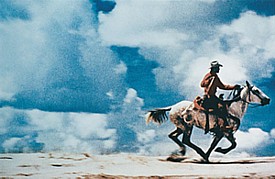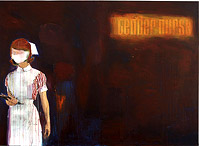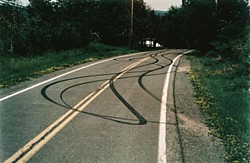main: October 2007 Archives

Richard Prince, Untitled (Cowboy), 1989. One of two Ektacolor prints.
Sold for $1,248,000.00 at a Christie's auction in 2005.
Someday My Prints Will Come
Sometimes the best work of even a very good artist needs to be underlined, leaving the uninspired trials and repetitions off to one side. Many careers would profit from pruning. But by whom? We like to think that artists know best, but this has not always proven to be the case.
Just listen to what artists say about other artists, whom they praise and whom they denigrate. Liking what confirms their own efforts, not all artists are blessed with good taste. Nor are we really to believe that most curators and critics can rise above the exigent or, in the case of the critics, the way a phrase (whether of praise or damnation) rolls off the tongue.
Or is it good taste -- and, some say, originality -- that needs to be subverted?
"Richard Prince: Spiritual America" (!), at the Guggenheim through January 9, proves that, contrary to received opinion, this particular artist did not dismantle originality during the first run of Appropriation Art. Others more focused did a better job of that. Prince, it now seems, has had too many mixed motives.
This sprawling exposition of what appears to be every work that Prince ever sold was organized by Nancy Spector, Chief Curator of the Guggenheim, "in close collaboration with the artist." Is the latter phrase, Spector's way of getting off the hook?
In the interest of transparency, we really do need to know that although the show's curator of record is Spector, the artist had considerable input, as the website overview announces. And, according to the handout, not only Deutsche Bank, but dealers Barbara Gladstone and Larry Gagosian helped make the exhibition possible. And Sotheby's.
Does Deutsche Bank own any artworks by Prince? Dealers can supply the names and addresses of collectors who own artworks that need to be borrowed, but we also know that if dealers have some Princes in their back rooms, an exhibition at the Guggenheim can't hurt. Should a museum accept favors from an auction house that may have resold a few Prince pieces at high prices and with considerable profit in commissions?
And, by the way, Lisa Dennison, until quite recently the director at the Guggenheim, is now at Sotheby's. Why? Read Carl Swanson's devastating piece in New York Magazine: "Why Lisa Dennison Bolted The Top Slot At The Guggenheim." [click: HERE].
The credits for the Prince show also include: "and those who wish to remain anonymous." Who might these be?
Unlike in the past, when outside assistance to museums was usually concealed (because of guilt?), I prefer all cards being put on the table. You know who to blame. Nevertheless, saying something is so doesn't make it right. This is the very American foolishness that mistakes honesty for absolution. I did indeed steal that cookie, so now that I have confessed, shouldn't I be able to eat it? This tactic is inappropriate even for athletes who lie about drug use, and, of course, for politicians.

Prince, Tender Nurse, 2002.
Sold for $2,256,000.00 at a Phillips de Pury auction in 2006.
Prince Charming
The Prince exhibition takes up virtually the entire Guggenheim. Strolling up or down the ramp, one wonders why. Some artists are enamored of everything they make, and Prince unreigned seems to be one of those.
I do like the anti-chronological layout. Prince cycles through various product lines, jumping back and forth, picking up lost trains of thought (as it were) or seeing new possibilities. So I am glad that Prince has legitimized this nontraditional strategy. He has brazenly juggled the re-photographed advertising photos, the joke paintings, the auto hoods. The latter run has transmogrified into large auto chunks and finally a full-scale, functioning competition car (not in the exhibition). The outrageous "Nurse Paintings" (based on paperback covers) re-appear as his recent de Kooning redo: de Kooning's "Women" with sex changes.
Is Prince really out to deconstruct the rigid and rigidifying oeuvre as assembled by critics and art historians -- progress and evolution along a single line -- or is he just planting a lot of seeds to see which ones grow? If one product line takes off, just make more?
We could also see him, given his interest in vintage cars and car culture, as an old-fashioned car company like G.M. He makes convertibles, pickup trucks, sedans and SUVs, and even though they change a little bit from year to year and are branded as Chevies, Buicks, Oldsmobiles or Cadillacs, they are all GM. Prince gambles that the results of his gambit will be all-Prince across all product platforms.
The bad news is that Prince seems to illustrate the results of the counterintuitive advice that began to circulate in the late '70: for collectors to love you, you gotta have product. Buyers need to see many examples of your work out in the marketplace to feel their investment will be upheld. This was explained to me by a notoriously uneven and overproductive artist whose star has now faded. What once worked for Andy Warhol doesn't work for all.
The good news about Prince is that the few re-photographed Marlboro cowboy ads are brilliant.
The bad news is that the other re-photographed ads, then later the composites of fanzine photos and collectibles, and certainly the condescending blowups of snapshots of motorcycle mamas from biker mags, are neither clever, telling, nor particularly interesting to look at.
The good news is that the automobile hoods -- sculpture/painting hybrids -- are consistently first-rate.
The bad news is that the hand-lettered joke paintings are truly banal, whether the sources are Borscht Belt comedy or New Yorker smarm; whether they are naked texts, cartoons with inappropriate texts, or texts with multiple overlays. Watching the Acoustiguided viewers at the Gugg, one may note not a smile or a laugh. Surely, one of each joke-variation or background would have been enough to get the joke.
The good news is that the Nurse Paintings are fine and funny. And the new de Kooning jokes are like a feminist's revenge. So perhaps, alas, Prince is making fun of feminism as well as de Kooning's purported sexism.
The bad news is that I do not know what to make of the two recent auto-tire "planters" except to see them in the context of the artist's other odes to upstate New York working-class culture in the form of his own depressing photographs. If there is irony here, it is undeserved and really kind of insulting. One good skid photo -- Untitled (upstate), 1995-99 -- does not excuse the rest.
Prince Deposed

Prince: Untitled (Upstate), 1995-99, Ektacolor photograph, edition of two prints.
Prince could be seen as our very own Richard Hamilton. Hamilton is generally credited with the invention of British Pop on the strength of his collage called Just what is it that makes today's homes so different, so appealing? (1959). However, Hamilton, unlike Prince, had the good grace to be less repetitive and less productive.
Prince and/or curator Spector and/or art market agendas and market demand have jeopardized the genuine shock of the rephotographed cowboy ads. Profusion can be an antidote to paralysis, or a symptom of a lack of inspiration. It can also suggest how collaborative most art production really is, and I do not mean just among artists. If selectivity is creativity, then dealers, curators, critics and collectors collaborate with all the artists they smile upon. Great artists choose their collaborators very carefully, or have been the benefactors of luck.
But in the case of Prince, it is as if Marcel Duchamp, enchanted by the reception for Nude Descending a Staircase, had gone on to produce hundreds of nudes descending hundreds of slightly different flights of stairs.
FOR AN AUTOMATIC ARTOPIA ALERT FOR NEW ESSAYS
E-MAIL: perreault@aol.com.
AJ Ads
AJ Blogs
AJBlogCentral | rssculture
Terry Teachout on the arts in New York City
Andrew Taylor on the business of arts & culture
rock culture approximately
Laura Collins-Hughes on arts, culture and coverage
Richard Kessler on arts education
Douglas McLennan's blog
Dalouge Smith advocates for the Arts
Art from the American Outback
For immediate release: the arts are marketable
No genre is the new genre
David Jays on theatre and dance
Paul Levy measures the Angles
Judith H. Dobrzynski on Culture
John Rockwell on the arts
Jan Herman - arts, media & culture with 'tude
dance
Apollinaire Scherr talks about dance
Tobi Tobias on dance et al...
jazz
Howard Mandel's freelance Urban Improvisation
Focus on New Orleans. Jazz and Other Sounds
Doug Ramsey on Jazz and other matters...
media
Jeff Weinstein's Cultural Mixology
Martha Bayles on Film...
classical music
Fresh ideas on building arts communities
Greg Sandow performs a book-in-progress
Exploring Orchestras w/ Henry Fogel
Harvey Sachs on music, and various digressions
Bruce Brubaker on all things Piano
Kyle Gann on music after the fact
Greg Sandow on the future of Classical Music
Norman Lebrecht on Shifting Sound Worlds
publishing
Jerome Weeks on Books
Scott McLemee on books, ideas & trash-culture ephemera
theatre
Wendy Rosenfield: covering drama, onstage and off
Chloe Veltman on how culture will save the world
visual
Public Art, Public Space
Regina Hackett takes her Art To Go
John Perreault's art diary
Lee Rosenbaum's Cultural Commentary
Tyler Green's modern & contemporary art blog
